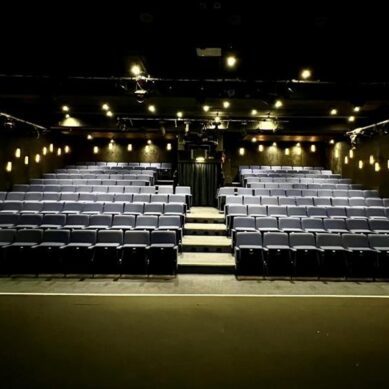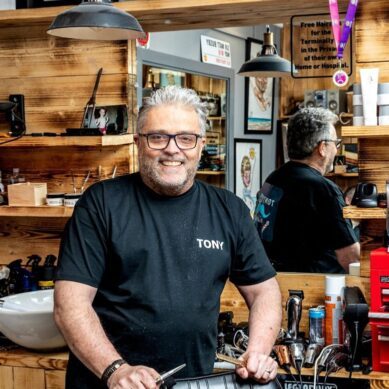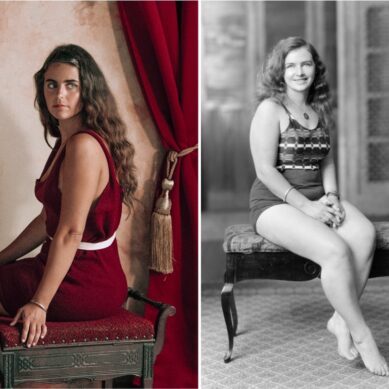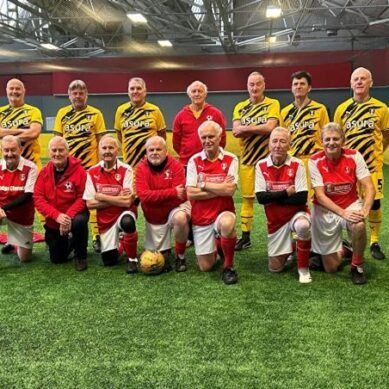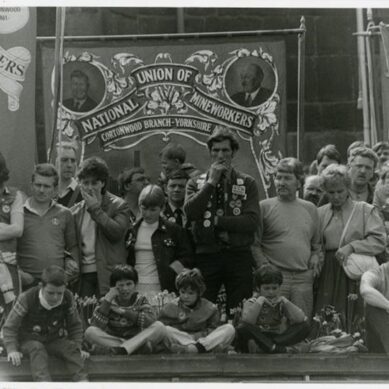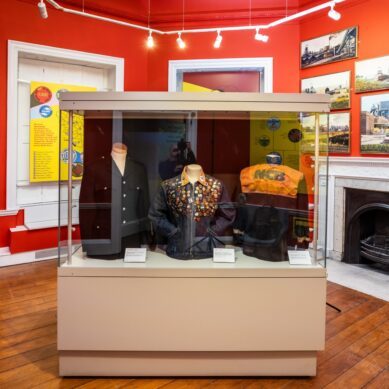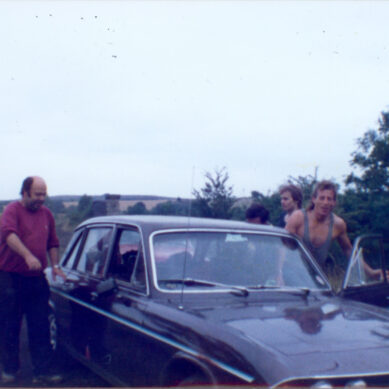Just like people, buttons come in all shapes and sizes. And just like people, each individual button has its own special purpose, each with a different story to tell.

Big, shiny gold-rimmed ones that fastened up your grandfather’s old duster coat; dainty pearlescent domes fixing the collar of your mother’s best blouse; cute pastel-coloured apples, flowers or animals finishing off a child’s hand-knitted cardigan; and that one perfect button that made a good replacement eye for dear old teddy ted.
It is the intrigue into the back stories and memories of these sewing staples that first set the bobbin rolling for Elsecar Heritage Centre’s artist in residence, Gemma Nemer. Her interest in textiles has led to her creating large-scale installations interwoven with the heart and stories of different communities.
With her vibrant red victory rolls, chintzy floral tea dress and a slick of red lippy, 36-year-old Gemma wouldn’t look out of place Lindy hopping her way back to the 1940s. And her love of nostalgia has seen her spend her career reconstructing history with a needle and thread.
Like many children growing up, Gemma was always fascinated by what lie inside her grandmother’s button tin.
But while some children may have been disheartened when greedily popping open the old biscuit or chocolate tin to find its sweet treats replaced with haberdashery, Gemma was enthralled by the treasure trove of buttons, thimbles and knick-knacks that glistened inside.
When she wasn’t spending hour after hour sorting the hundreds of buttons into piles, a young Gemma would make outfits for her dolls out of the scraps of fabric left over from her mum’s handmade clothes.
“My dad is Palestinian and when we moved to Wombwell, Barnsley from Jordan when I was a child we literally had nothing. Mum was very creative and loved to make do and mend. She was a former fashion student so she made all of my clothes growing up.
“I’d wear these amazing Victorian style pinafores with hand-stitched smocking and always had ribbons in my hair. Grandma used to tie my hair around rags to create ringlets – I looked like something out of a period drama which didn’t always go down well at school,” Gemma says.
Mum Heather always encouraged her daughter’s interest in sewing and crafts which carried on throughout her education, with Gemma going on to achieve a degree in Fine Art at Sheffield Hallam University.
While studying, Gemma took inspiration from her mum and began experimenting with wearable art, crafting couture neck pieces adorned with lace and embellishments. Having grown up around old-fashioned techniques, Gemma combined her love of vintage, recycled materials and methods like doilies and patchwork but put a modern twist on her pieces.
“I’ve always found treasure in other people’s discarded or lost objects and get a real rush from rummaging through car boot sales or charity shops. The nostalgia surrounding the items I’ve hoarded throughout the years is what often inspires my work.”
Following her graduation in 2006, Gemma was put forward to exhibit her work at Yorkshire Sculpture Park which quickly gathered momentum to open up a whole new world of opportunities.

“I remember being so nervous when I laid all my work out but they really loved what I’d created and offered me two cabinets which was huge for a new artist.
“They gave me my first real chance, something I’d always dreamed of. Dreaming can be a good thing but these days I think children aren’t always encouraged to dream.
It was at this time that the sculpture park was developing their education programme and Gemma was invited to teach fabric manipulation, which subsequently led to her touring Yorkshire galleries to teach and showcase her work.
Along with Millennium Gallery and Cupola Gallery in Sheffield, the tour also included Saltbox Gallery in York, Leeds Craft and Design Gallery and the Harley Gallery on Worksop’s Welbeck Estate.
“Having so many galleries to exhibit in meant I had lots of pieces to create so I spent many a night sat on the edge of my bed with a camping table set up on which to make my jewellery.”
But some light reprieve came in 2010; leading curator of Cupola Gallery, Karen Sherwood, had seen Gemma’s talents and offered her the chance of studio space in the Rotherham’s Imperial Buildings with which she was involved in developing. And so, The Button Tin Kiosk was born
Based in a listed building, the new studio was brimming with history which resonated with the jewellery that formed Gemma’s primary collection.
“Many of my early memories are of playing in Grandma’s button tin – the smell of the tin, the many colours inside. I wanted to recreate that warm, welcoming feel in a studio, like a giant hug filled with laughter and human connection that would evoke nostalgia, tears and euphoria.
People came from across the country and beyond to visit The Button Tin, from Newcastle to London, with Gemma also having an international following. Some had seen Gemma’s work in the various Yorkshire galleries, others in crafting magazines such as Mollie Makes and Handmade Living
And while most may have guffawed at the thought of a studio in Rotherham, they were left eating their words at the hidden surprise they were greeted with; an unexpected piece of art within itself
“A lot of people never took me all too seriously when I said I was based in Rotherham, but this made me more determined to prove you can be from a small town and still be successful.
“It was a fight to break the stigma and convince people to visit Rotherham, but one of the reasons I stayed there was to help generate interest which would then hopefully spread to other businesses in the town.
The Button Tin quickly became an arts hub within the town, opening doors to extensive community projects which would go on to add yet another piece on to Gemma’s patchwork career.
Local charities sought Gemma’s help to create large-scale textile installations to engage with the community, each embroidered with their own personal message.

A piano covered in vintage fabrics, poems and songs for Headway, a local brain injury support service. Vintage style flowers crafted from traditional ethnic fabrics for REMA, Rotherham Ethnic Minority Alliance, to outshine racism and hate crime faced in the town.
Celebrating faith and diversity with embellished wings for the Love is Louder Festival of Angels. And breaking down age barriers between the elderly and schoolchildren with a patchwork quilt created for Holmfirth-based intergenerational project, Sharing Memories.
But after seven happy years in the town, the building in which Gemma’s quirky kiosk stood was laced with problems and so Gemma was forced to move out of the eclectic studio she’d created.
By then, Gemma had also welcomed a new addition to her brood with daughter, Frida, and so it was crucial she find alternative premises to help continue working. The family had moved to Elsecar in one of the Earl’s former mining cottages and, for the meantime, The Button Tin operated from Gemma’s garage which had been turned into a makeshift workshop
“When you become a mum, people often presume you can’t or don’t want to work but for me it was the complete opposite. I’m self-employed so I had to carry on working and exhibiting, sometimes seven days a week.”
Community projects continued to come her way and Gemma found herself travelling near and far, creating textile boats in Leicester for People’s Express who work with people with autism and Asperger’s, or being the resident ‘make do and mender’ at York’s Vintage Festival – all with little Frida on board.
A short stint in the Sorting Office arts space ensued before Gemma was approached by Great Place Wentworth and Elsecar; a new Heritage Lottery and Arts Council Funded project celebrating the fascinating heritage of Wentworth and Elsecar through the arts. This initiative is also in partnership and funded by both Rotherham and Barnsley Council.
The scheme’s first project was to paint Elsecar village blue and yellow for last summer’s Tour de Yorkshire, with Gemma commissioned to engage the village through what they were calling a mass mobilisation.
“It was the largest project I’ve ever worked on and, together with the local schools, businesses and residents, we managed to transform the village into an actual art installation.”
Inspired by King George V’s visit to Elsecar in the early 1900s, Gemma set about creating a true royal welcome. Banners with Yorkshire slang were hung from buildings. Trees in the park were yarn-bombed. Handmade flags, bunting, tassels and bows lined the route as spectators flocked in their thousands to see the cyclists flash through the village.
“It was really difficult to put together but the end result was just electric and Elsecar was named the second best dressed village on the whole four-day route.
“All these tough old Yorkshiremen in the pub were crying saying it was the best village day they’d seen in 40 years. I didn’t have to buy my own pint for months which was a bonus!”
Following Tour De Yorkshire’s success, Gemma was offered a workshop at the heritage centre – her little bright button stitched firmly back in place for all to see again.
True to her heritage drenched mantra, the reincarnated Button Tin now stands proudly as The Way Station and is based in the Earl’s Station Lounge, a quaint stone building at the side of the former trainline. Here, esteemed guests of the Earl would have departed the train and entered the lounge for a glass of sherry or port before embarking up the grand mahogany staircase for their meeting with the Earl.
Today, Gemma has given the studio a Victorian Parlour or Granny’s front room feel, a homely space filled with pin cushions, cotton bobbins and wooden dollies.
The high ceilings give great expanse from which to showcase her textile displays and current projects, with shelving housing her own antique charms and crockery.
The grand staircase is heaving with vintage Singer sewing machines, the walls lined with her Tour de Yorkshire banners shouting quips like ‘Gi ore wi thissen’. A rainbow of tassels fall in a riot from the banister, while a washing line of aprons and vintage garments stretch across the landing.
Although a self-confessed hoarder, Gemma says she’s fortunate that a lot of the items she has collected over the years have been kindly donated by local people.
“I can never have too much of anything and the donations have been endless. Somehow, the thing I most need magically finds its way to the studio, be it thread or even a new set of drawers.”
Since moving into her new studio in August last year, Gemma finally found the time to have an official launch in March to coincide with her new project, Common Threads.
On the day, the event saw around 100 jovial faces come through the door every hour to marvel at the cosy corner of Gemma’s world and reminisce about the good old days.
The project, in partnership with the Great Place scheme, has been devised to celebrate the inspirational women from Elsecar and Wentworth in a matter of different mediums. Using mainly embroidery, the finished pieces will be showcased around the two villages in a bid to highlight the incredible her-story of these worthy women.
In the first two weeks since launching, Gemma welcomed over 200 people to her workshops, aged 4 to 92.
“The interest I’ve already seen shows just how important arts and heritage are. People want to take ownership of their own history and most come to learn skills or more about the villages where they are from.
“I have been given a huge responsibility and a loud voice to get people involved and to build relationships within the community which I am already starting to see.”

Taking inspiration from what would have been a means of relaxation in the post-war era for some women, Gemma’s workshops focus on embroidery and patchwork using original materials that she’s collected over the years.
Young children bring in photos of the women inspirational to them, with many smiling faces of mums, nans and beloved teachers. Friends old and new gather around to share memories of the characters of yesteryear. Everyone connected by a common thread of happiness.
“It’s been great to see all ages getting involved. There’s a six-year-old who comes to the children’s class who won’t come down for her tea and shouts ‘Leave me alone mum, I’m sewing.’ Then we have a teenager who’s set up a sewing group to teach her friends what she learns at the workshops. Even my 73-year-old neighbour, Beryl, says she’s finally found somewhere she belongs after spending a lot of time on her own.”
Since opening up her studio, Gemma has been inundated with fascinating stories about remarkable women and hopes to include as many snippets as possible into the installation.
There’s Miss Agnes Bertram, Wentworth’s former piano tutor, whose handwriting will be hand-embroidered onto sheets of music. Or Nurse Walker, a midwife from Elsecar, who delivered 3,000 babies with just a bicycle and suitcase in her kit. Excerpts from her log and medical research books will be printed on to vintage christening gowns.
One volunteer, Barbara Arnold, was a student at Lady Mabel College, Wentworth Woodhouse. As part of the uniform, the students wore cloaks, which Gemma is hoping to recreate as part of the project with the help of Lady Mabel archivist, Sue Gravil.
“When you look at how these ladies were taught the Laban Theory and science of movement you realise the concept was way ahead of its time. I wanted to include a legacy to this and so we’re using Barbara’s old cloak to recreate a pattern from which we’ll make our own from 100-year-old linen and silks.”
“Different narratives such as a school song will be embroidered and women mid movement will be screen printed on to the cloaks and we’ll then showcase them in the Pillared Hall at Wentworth Woodhouse.”
Getting through the extremely large work load has been very difficult without any fellow team members but Gemma has been fortunate to have the help of many volunteers including one kind, selfless and generous Elsecar lady called Chris Arnold.
“Chris has stayed many a late night helping me create work and prepare for workshops. Over the past year I could not have done it without her help and now we are very good friends.”
While sharing her knowledge with the volunteers, Gemma has also taken advantage of the chance to upskill and learn from others along the way, picking up tips and tricks from the self-taught sewers.
She is also working with art degree students at University Campus Barnsley and their artist in residence, Sharon Middleton, on a skill exchange venture.
“One thing I wish I’d had the chance to do while studying is go to a working studio and speak to an artist about how they ‘made it.’ I’ve also been so busy that I’ve never had a proper chance to develop my own practice.
“I’ve offered to give masterclasses on how to run an art-based business – the good and bad bits – and the students are going to refresh my rusty screen printing skills in return so I can use the technique in the Common Threads project.”
Although work takes up a large slot of her time, family is very important to Gemma and little Frida spends a lot of her time in the studio making things – and unfortunately snipping them.
Cut from the same cloth as her mum, she too loves to play with the fabric scraps and buttons and is a very lucky little three-year-old constantly surrounded by a world of love, colour and excitement.
“Before she was born I made her an apron that she wears when we bake together, and I’ve also customised her clothes with ric racs and trims.
“Her bedroom is like one big textile installation with ribbons and fabrics hanging from the walls and she even has her own textile tipi that she loves to chill in while I sew.”

And who knows, she may just add a new generation of memories, stories and buttons into the family sewing box in years to come. For more details on how to get involved with the Common Threads Project or to arrange a visit to The Way Station Studio at Elsecar Heritage Centre, please contact Gemma at gemma.nemer@hotmail.co.uk. Or find her on Facebook as ‘Gemma Nemer Artist In Residence Wentworth & Elsecar’ and ‘The Button Tin’. You can also watch The Button Tin film, a beautiful stop motion animation about The Imperial Buildings residency, on Vimeo by searching ‘The Button Tin Gemma Nemer’.
